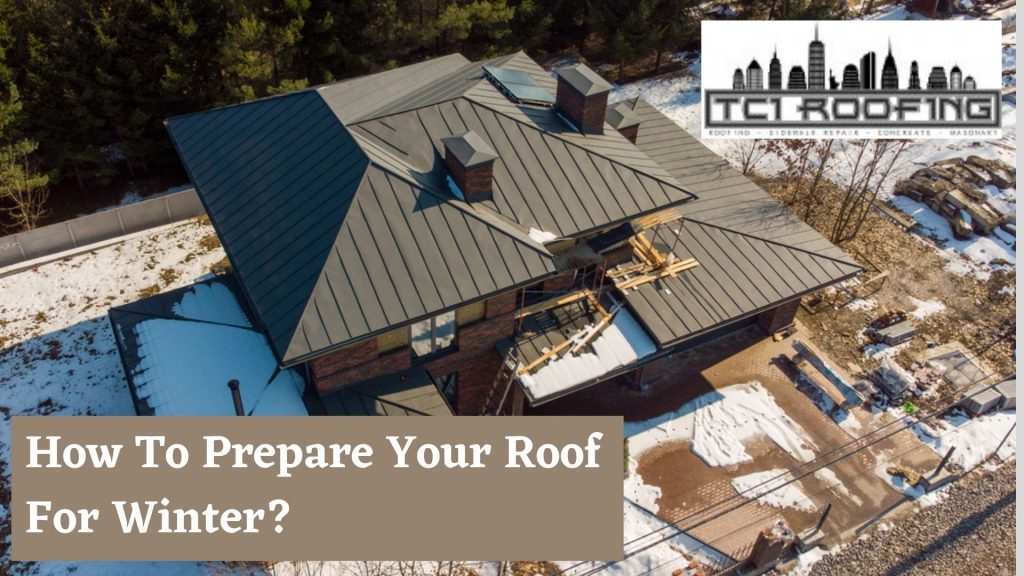Preparing your roof for winter is a common roofing repair that should be done every year. The roof protects the home from extreme weather, and also helps insulate it to keep it warm in the winter. If not properly prepared, roofing repairs can cost homeowners thousands of dollars due to water damage caused by ice dams or leaks. We will discuss how you can prepare your roof for winter so that you don’t have any surprises come springtime if you might need to have a roof replacement, roofing repair, and others!
Prepare your Roof for Winter
When it comes to preparing your home for cold weather and freezing temperatures, overlooking your roof can be an expensive blunder, and might see some roof leaks. Ensuring your roof is ready for the harsh weather conditions throughout the winter months is an essential step in winterizing your home. You can help your property stay warm and avoid costly repairs caused by leaks and ice dams by completing routine maintenance on your roof before winter sets in.
4 Things You Can Do to Prepare Your Roof for Winter
Before winter arrives, there are a few things you should do to prepare your roof for the season. These were listed for Four to summarize the most critical things to perform to prepare your roof for the winter before hiring the best roof repair.
Clean Your Gutters
A clean gutter system is effective. Gutter cleaning should be done at least twice a year, once in the spring and once in the fall, to extend the life of your gutters and it will also help to avoid a roof leak or other minor roof repairs. The wind and rainstorms that accompany autumn can clog your gutters and drains. In addition, the low temperatures might develop ice dams in your gutters if they aren’t thoroughly cleaned up before winter. This will inevitably result in costly repairs. Clear your gutters of leaves, twigs, nests, and other garbage now that the Utah fall season is in full swing. You’ll also want to make sure your system is running smoothly and efficiently, and you’ll want to address any issues as soon as possible before hiring roof repair companies or a roofing contractor.
Consider an Ice Melting System
Snow falls on your roof throughout the winter, melts, and runs down to the overhanging area of your roof. Because there is no insulation beneath this section of your roof, the water drips and immediately freezes, generating icicles. Icicles, while beautiful, are a severe safety hazard to persons walking below, either by breaking and colliding with them or by pouring onto sidewalks and driveways, freezing and producing dangerously slick ice patches on the ground below. To avoid this, install an ice melting system, sometimes known as a heat cable. Ice dams and icicles are avoided with this self-regulating heat tape.
Professional Inspection
Before the arrival of big snowstorms, your roof must be free of leaks. A basic roof inspection performed by a qualified specialist can immediately identify any possible problems, such as curling or missing shingles, stains or wet areas, and other symptoms of deterioration before asking help from multiple roofing companies.
Repair Damaged Areas
You’ll know exactly where your roof stands after your assessment. Missing shingles, broken flashing, and other damaged areas make your home vulnerable to leaks, which can cause substantial (and costly!) water damage. Contact a competent roof specialist to prevent water from entering your home and fix damaged areas before they develop.
Snow and Ice Slide off of Metal Roofs
Snow and ice accumulate on your roof during a winter storm. Temperatures change during and after the storm, producing melting and refreezing. This allows water to slowly seep into minor cracks and holes in your roof, where it freezes and expands. Severe roof damage, such as cracks and holes, is frequently the outcome.
Because ice and snow physically slide off the roof, metal roofing virtually eliminates this danger with its roof vents or roof fixtures. Ice dams cannot develop because there is nothing for the ice to adhere to. The odds of damage during winter storms are substantially lower with a metal roof than with asphalt shingles since there is no heavy snow or ice thawing and refreezing on your top.
They Are Energy Efficient
Because metal is a reflective surface, metal roofs reflect the sun, keeping your home cool in the summer. However, they also perform a fantastic job keeping the heat in during the winter. According to one study, many roof types allow attic temperatures to drop dramatically in cold weather, but metal roofs consistently outperformed them by at least 20 degrees.
Conclusion
Ignoring your roof when prepping your home for cold weather and freezing temperatures can be a costly mistake. Winterizing your roof is a basic roofing repair that should be done at least once a year. The roof protects the house from the elements and insulates it in the winter, keeping it warm. In addition, a well-maintained gutter system is efficient. To extend the longevity of your gutters, you should clean them at least twice a year, once in the spring and once in the fall. Autumn’s wind and rainstorms have the potential to block your gutters and drains. Also, consider the roof repair costs from the local roofing company.

